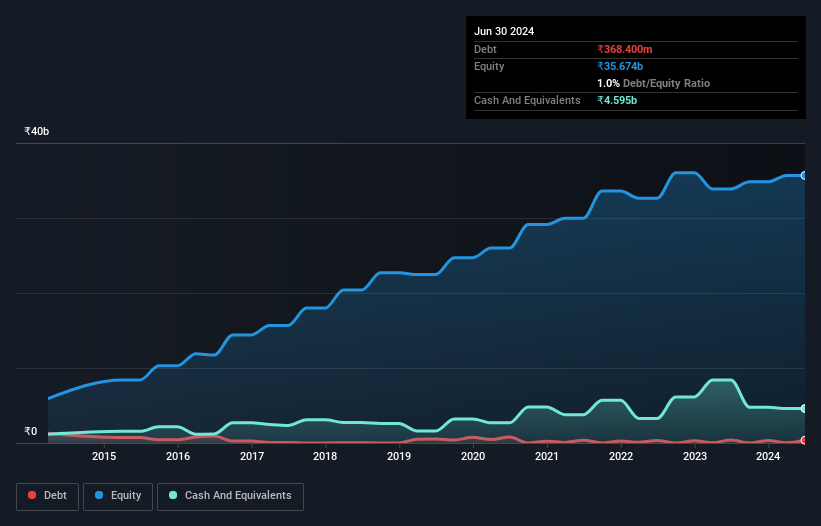We Think Ajanta Pharma (NSE:AJANTPHARM) Can Manage Its Debt With Ease

David Iben put it well when he said, 'Volatility is not a risk we care about. What we care about is avoiding the permanent loss of capital.' So it might be obvious that you need to consider debt, when you think about how risky any given stock is, because too much debt can sink a company. Importantly, Ajanta Pharma Limited (NSE:AJANTPHARM) does carry debt. But the real question is whether this debt is making the company risky.
When Is Debt Dangerous?
Generally speaking, debt only becomes a real problem when a company can't easily pay it off, either by raising capital or with its own cash flow. Ultimately, if the company can't fulfill its legal obligations to repay debt, shareholders could walk away with nothing. However, a more frequent (but still costly) occurrence is where a company must issue shares at bargain-basement prices, permanently diluting shareholders, just to shore up its balance sheet. Of course, the upside of debt is that it often represents cheap capital, especially when it replaces dilution in a company with the ability to reinvest at high rates of return. When we think about a company's use of debt, we first look at cash and debt together.
Check out our latest analysis for Ajanta Pharma
What Is Ajanta Pharma's Net Debt?
The image below, which you can click on for greater detail, shows that Ajanta Pharma had debt of ₹368.4m at the end of March 2024, a reduction from ₹394.7m over a year. However, its balance sheet shows it holds ₹4.60b in cash, so it actually has ₹4.23b net cash.

How Strong Is Ajanta Pharma's Balance Sheet?
Zooming in on the latest balance sheet data, we can see that Ajanta Pharma had liabilities of ₹8.96b due within 12 months and liabilities of ₹1.75b due beyond that. Offsetting these obligations, it had cash of ₹4.60b as well as receivables valued at ₹13.5b due within 12 months. So it actually has ₹7.39b more liquid assets than total liabilities.
Having regard to Ajanta Pharma's size, it seems that its liquid assets are well balanced with its total liabilities. So while it's hard to imagine that the ₹391.5b company is struggling for cash, we still think it's worth monitoring its balance sheet. Simply put, the fact that Ajanta Pharma has more cash than debt is arguably a good indication that it can manage its debt safely.
In addition to that, we're happy to report that Ajanta Pharma has boosted its EBIT by 54%, thus reducing the spectre of future debt repayments. When analysing debt levels, the balance sheet is the obvious place to start. But ultimately the future profitability of the business will decide if Ajanta Pharma can strengthen its balance sheet over time. So if you want to see what the professionals think, you might find this free report on analyst profit forecasts to be interesting.
Finally, a business needs free cash flow to pay off debt; accounting profits just don't cut it. Ajanta Pharma may have net cash on the balance sheet, but it is still interesting to look at how well the business converts its earnings before interest and tax (EBIT) to free cash flow, because that will influence both its need for, and its capacity to manage debt. During the last three years, Ajanta Pharma produced sturdy free cash flow equating to 65% of its EBIT, about what we'd expect. This cold hard cash means it can reduce its debt when it wants to.
Summing Up
While we empathize with investors who find debt concerning, you should keep in mind that Ajanta Pharma has net cash of ₹4.23b, as well as more liquid assets than liabilities. And we liked the look of last year's 54% year-on-year EBIT growth. So is Ajanta Pharma's debt a risk? It doesn't seem so to us. The balance sheet is clearly the area to focus on when you are analysing debt. However, not all investment risk resides within the balance sheet - far from it. For example - Ajanta Pharma has 1 warning sign we think you should be aware of.
At the end of the day, it's often better to focus on companies that are free from net debt. You can access our special list of such companies (all with a track record of profit growth). It's free.
New: Manage All Your Stock Portfolios in One Place
We've created the ultimate portfolio companion for stock investors, and it's free.
• Connect an unlimited number of Portfolios and see your total in one currency
• Be alerted to new Warning Signs or Risks via email or mobile
• Track the Fair Value of your stocks
Have feedback on this article? Concerned about the content? Get in touch with us directly. Alternatively, email editorial-team (at) simplywallst.com.
This article by Simply Wall St is general in nature. We provide commentary based on historical data and analyst forecasts only using an unbiased methodology and our articles are not intended to be financial advice. It does not constitute a recommendation to buy or sell any stock, and does not take account of your objectives, or your financial situation. We aim to bring you long-term focused analysis driven by fundamental data. Note that our analysis may not factor in the latest price-sensitive company announcements or qualitative material. Simply Wall St has no position in any stocks mentioned.
About NSEI:AJANTPHARM
Ajanta Pharma
A specialty pharmaceutical formulation company, together with its subsidiaries, develops, manufactures, and markets speciality pharmaceutical finished dosages.
Flawless balance sheet with solid track record and pays a dividend.
Market Insights
Community Narratives



